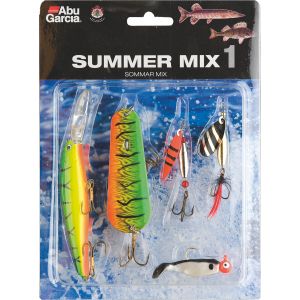Catch Perch
For many, perch is the first fish in their sport fishing career. Often, the first perch is caught on a worm while fishing from a dock with an older relative, while others discover perch fishing with a jig or spinner. Regardless, perch is one of the most common Swedish fish species and a highly appreciated catch among sport fishermen.
Equipment for Perch Fishing
The most common setup for perch fishing is a spinning rod around 7 feet long, with a casting weight of 5-15g, paired with a reel in size 2000. Combined with a braided line of about 0.12-0.15mm, this makes for an excellent perch fishing setup. If you are new to perch fishing, a good tip is to buy a ready-made combo.
All Perch Rods found here.
All Perch reels found here.
All Perch Combos found here.
In recent years, fishing with light spinning gear with low-profile reels has become increasingly popular among Scandinavian perch fishermen. Much inspiration comes from American bass fishing, where spinning rods and multiplier reels are standard. With a spinning setup, you can retrieve the lure more actively and also cast with greater precision, which is an advantage in tight spaces.
For the casual angler, a simple pole with a worm works excellently. If you want to increase the chances of catching a big perch, you could switch the worm for a bleak.
Lures for Perch
There are many different methods and baits to entice perch to bite. The method often varies based on the season, water temperature, and other factors that influence when, where, and how the perch feed. The most common lures found in a perch fisherman's tackle box are various types of jigs, spinners, and small hair lures such as wobblers or crankbaits. Jig fishing, in particular, has evolved significantly over recent years, and various finesse techniques such as dropshot, ned rig, Carolina rig, and Texas rig are now commonly used in Swedish waters.
All Perch baits and lures found here.
Regardless of the technique preferred, it's a good idea to have several different types of lures in various colors and sizes in your tackle box. This way, you can cover many different situations. A good start is to buy a ready-made lure kit.
Three Tips for Better Perch Fishing:
- Perch have no teeth and can sometimes be sensitive to steel leaders, so it's best to use a fluorocarbon leader around 0.40mm, a thin tungsten leader, or similar. If there are no pike in the lake, you can fish without a leader.
- Crayfish are a favorite food for large perch, so if you fish in a lake with crayfish, it can be very effective to fish near the bottom with crayfish imitations.
- Perch often swim in schools, so if you catch one, chances are high that there are more in the area. Seize the opportunity to keep your gear in the water when the perch are biting!

![mobile-menu-bg]()

![Berkley Hit Stick 7 cm [6.9 g] S](https://d1ry2pq5lodqfa.cloudfront.net/media/catalog/product/cache/19125e564c9e8562edf69a4be0af0029/1/5/1531639_1_1.jpg)

![Svartzonker McPerch Shad 7.5 cm [3 g] 8-pack](https://d1ry2pq5lodqfa.cloudfront.net/media/catalog/product/cache/19125e564c9e8562edf69a4be0af0029/1/4/1446011_1_1.jpg)
![Berkley Hit Stick 15 cm [25.3 g] F](https://d1ry2pq5lodqfa.cloudfront.net/media/catalog/product/cache/19125e564c9e8562edf69a4be0af0029/1/5/1531664_1_1.jpg)
![Berkley PowerBait Power Swimmer Soft 7.1 cm [3 g] 8-pack](https://d1ry2pq5lodqfa.cloudfront.net/media/catalog/product/cache/19125e564c9e8562edf69a4be0af0029/1/5/1524053_1.jpg)
![Abu Garcia Droppen 5.3 cm [12 g] assorted colors 3-pack](https://d1ry2pq5lodqfa.cloudfront.net/media/catalog/product/cache/19125e564c9e8562edf69a4be0af0029/1/3/1392489_1_2.jpg)
![Berkley Hit Stick 12 cm [13.5 g] F](https://d1ry2pq5lodqfa.cloudfront.net/media/catalog/product/cache/19125e564c9e8562edf69a4be0af0029/1/5/1531656_1_1.jpg)

![Abu Garcia Droppen 4.4 cm [6 g] mixed colors 3-pack](https://d1ry2pq5lodqfa.cloudfront.net/media/catalog/product/cache/19125e564c9e8562edf69a4be0af0029/1/3/1397975_1.jpg)
![Svartzonker McPerch Curly 11 cm [4 g] 8-pack](https://d1ry2pq5lodqfa.cloudfront.net/media/catalog/product/cache/19125e564c9e8562edf69a4be0af0029/1/4/1446034_1_1.jpg)
![Westin Ned Worm 11 cm [7 g] 5-pack](https://d1ry2pq5lodqfa.cloudfront.net/media/catalog/product/cache/19125e564c9e8562edf69a4be0af0029/p/1/p182-6663-xxx_dark-water-mix_large_5.jpg)
![Berkley PowerBait Power Swimmer Soft 9.5 cm [7 g] 6-pack](https://d1ry2pq5lodqfa.cloudfront.net/media/catalog/product/cache/19125e564c9e8562edf69a4be0af0029/1/3/1386939_1_1.jpg)

![Berkley Pulse Realistic Roach 7 cm [7 g] jig kit 4-pack](https://d1ry2pq5lodqfa.cloudfront.net/media/catalog/product/cache/19125e564c9e8562edf69a4be0af0029/1/3/1392523_1.jpg)
![Savage Gravity Twitch SR 8.3 cm [10 g] SP](https://d1ry2pq5lodqfa.cloudfront.net/media/catalog/product/cache/19125e564c9e8562edf69a4be0af0029/1/3/1389686_1_1.jpg)
![Abu Garcia Tormentor 9 cm [12 g]](https://d1ry2pq5lodqfa.cloudfront.net/media/catalog/product/cache/19125e564c9e8562edf69a4be0af0029/1/0/1084310_1_1.jpg)
![Svartzonker McPerch Curly 8 cm [2 g] 8-pack](https://d1ry2pq5lodqfa.cloudfront.net/media/catalog/product/cache/19125e564c9e8562edf69a4be0af0029/1/4/1446025_1_1.jpg)
![Abu Garcia Droppen 4.6 cm [8 g] mixed colors 3-pack](https://d1ry2pq5lodqfa.cloudfront.net/media/catalog/product/cache/19125e564c9e8562edf69a4be0af0029/1/3/1392489_1_1.jpg)
![Blue Fox Vibrax UV 4 [10 g]](https://d1ry2pq5lodqfa.cloudfront.net/media/catalog/product/cache/19125e564c9e8562edf69a4be0af0029/1/0/102765_1.jpg)
![Abu Garcia Reflex Arctic 5.7 cm [12 g] copper, gold, black 3-pack](https://d1ry2pq5lodqfa.cloudfront.net/media/catalog/product/cache/19125e564c9e8562edf69a4be0af0029/1/5/1532137.jpg)
![Myran Wipp [3 g]](https://d1ry2pq5lodqfa.cloudfront.net/media/catalog/product/cache/19125e564c9e8562edf69a4be0af0029/W/_/W_SvOr_K_1_1.jpg)
![Blue Fox Minnow Super Vibrax 7.5 cm [13 g]](https://d1ry2pq5lodqfa.cloudfront.net/media/catalog/product/cache/19125e564c9e8562edf69a4be0af0029/1/0/102788_1.jpg)
![Svartzonker McPerch Shad 9 cm [5 g] 8-pack](https://d1ry2pq5lodqfa.cloudfront.net/media/catalog/product/cache/19125e564c9e8562edf69a4be0af0029/m/c/mcperch-shad-90_1_1.jpg)
![Effzett Slim Standard Spoon 5 cm [8 g] S](https://d1ry2pq5lodqfa.cloudfront.net/media/catalog/product/cache/19125e564c9e8562edf69a4be0af0029/S/V/SVS70536_1.jpg)